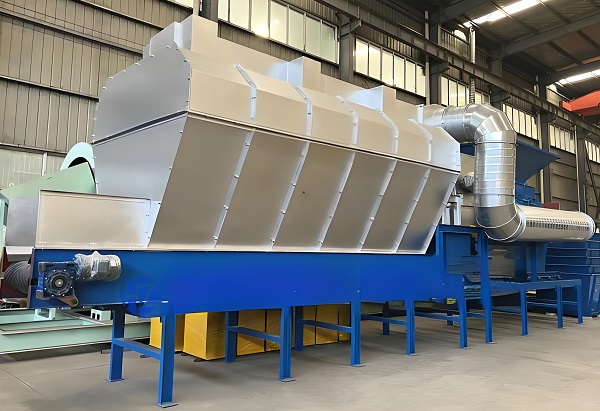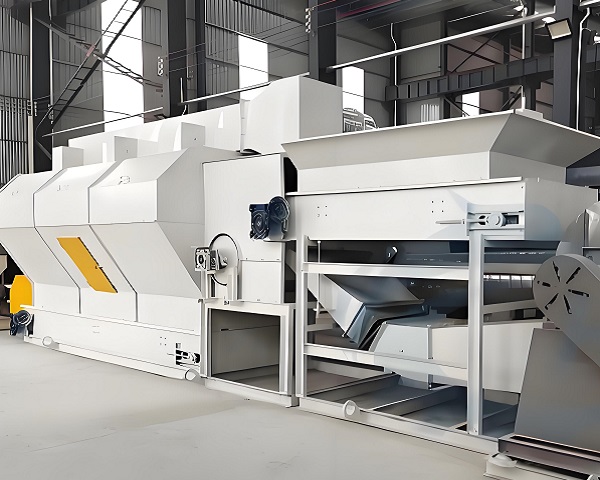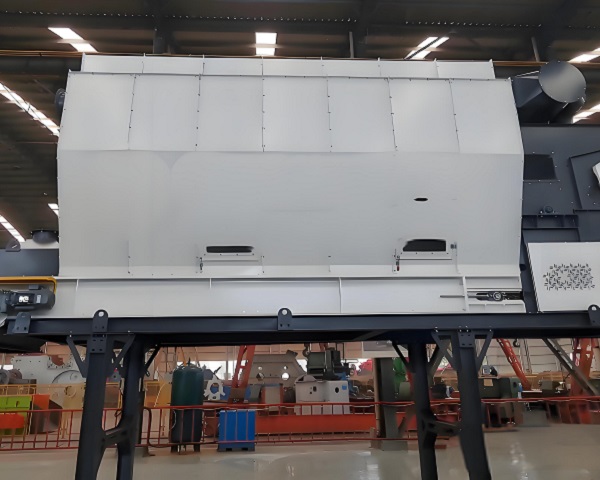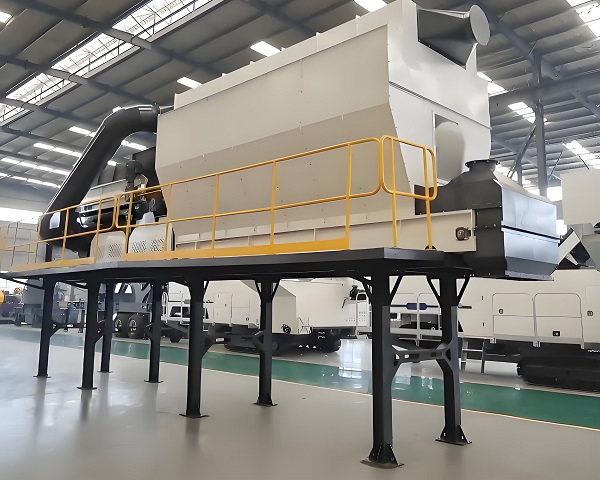In the waste reduction, resource recovery, and harmless treatment system, precise sorting is a crucial step. Air separators, leveraging the core principle of controllable airflow and material density differences, can efficiently separate lightweight and irregular waste without direct contact, overcoming the shortcomings of traditional screening equipment. They are widely applicable to various scenarios, including municipal solid waste, construction waste, and industrial solid waste, specifically addressing pain points such as the separation of heavy and light components and impurity removal, laying the foundation for subsequent resource recycling and processing optimization. The applicable waste types have been analyzed in detail below; here, we first clarify its core positioning and value.
As a "density sorting expert" in the waste sorting system, the air separator's core principle utilizes the differences in density, particle size, and shape of different waste components. Through air resistance and buoyancy generated by controllable airflow (such as negative pressure suction or positive pressure blowing), it achieves the separation of light and heavy materials. Its greatest advantage lies in its ability to efficiently sort lightweight, loose, or irregular waste that is difficult for traditional screening equipment to handle without direct contact, making it widely applicable to various scenarios such as municipal solid waste, construction waste, and industrial solid waste. The following analysis, combining the characteristics of waste components and sorting requirements, details the types of waste suitable for air separators and their application logic.
Municipal Solid Waste:

Focusing on "Separation of Light and Heavy Components" to Facilitate Resource Recycling and Incineration Municipal solid waste has a complex composition (including plastics, paper, textiles, kitchen waste, and construction waste). The core function of air separators is to separate "lightweight recyclables" from "heavy non-recyclables," paving the way for subsequent resource recycling and incineration. Air separators are particularly suitable for sorting the following two types of municipal solid waste components:
1. Lightweight Recyclables: Precise Separation of Plastics, Paper, and Textiles Lightweight components in municipal solid waste, such as plastics (e.g., plastic bags, beverage bottle fragments), paper (e.g., waste paper, cardboard box scraps), and textiles (e.g., old clothes, fabric scraps), typically have a density between 0.3-0.8 g/cm³ and good air permeability or bulkiness. They are easily blown or sucked away by airflow, making them the core sorting targets of air separators.
In municipal solid waste sorting lines, air separators are typically installed after manual sorting and after magnetic separation: after manual sorting to remove large items (such as furniture and glass) and magnetic separation to separate magnetic metals, the remaining waste enters the air separator via a conveyor belt. The equipment uses a negative pressure suction system (air velocity typically 8-15 m/s) to draw lightweight plastics, paper, and textiles to the upper separation channel, where they are collected by a cyclone separator, ultimately yielding a "lightweight recyclable mixture" with a purity of over 85%. Heavy components (such as kitchen waste, slag, and broken glass), due to their high density (above 1.0 g/cm³), are less affected by airflow and fall along the conveyor belt into the lower heavy material bin.
Data from a municipal solid waste sorting center in a certain city shows that the air separator achieves a 90% recycling rate for plastics, 82% for paper, and 75% for textiles, recovering approximately 5 tons of lightweight materials daily. After further manual sorting, the plastics and paper can be directly sold to recycling companies, generating over 800,000 yuan in economic benefits annually. Simultaneously, the proportion of kitchen waste in the separated heavy components increases to 70%, leading to a 15% increase in biogas production efficiency when the waste enters the anaerobic digestion system, achieving the dual value of "resource recovery" and "energy utilization."
2. Pre-sorting of Light and Heavy Components Before Incineration: Reducing Incineration Energy Consumption and Pollutant Emissions
For municipal solid waste primarily treated by incineration, the air separator can separate heavy, inert components (such as slag, small stones, and glass fragments) before incineration, reducing the amount of these non-combustible components entering the incinerator and lowering incineration energy consumption and slag production. These heavy components typically have a density above 2.0 g/cm³, significantly different from the density of light combustible components (plastics, paper, wood fragments), making them suitable for air separation.
In the pretreatment process of a waste incineration plant, municipal solid waste, after being crushed (particle size controlled below 100 mm), enters an air separator. The equipment employs a positive pressure blowing design (wind speed 12-18 m/s), blowing the light combustible components to the incinerator feed inlet, while the heavy, inert components fall into the collection bin. After implementation, the combustible content of the incinerator feed increased from 60% to 80%, the incineration temperature stabilized above 850℃ (meeting dioxin decomposition requirements), and the power generation per ton of waste increased by 20 kWh. Simultaneously, slag production decreased by 30%, the cost of subsequent landfill or resource utilization of slag decreased by 40%, and glass fragments in the heavy components can be further recycled, achieving the dual goals of "volume reduction" and "harmlessness."
Construction Waste:

Separating "Lightweight Impurities" from "Recycled Aggregate" to Improve Resource Utilization Purity
The core processing goal of construction waste is "recycled aggregate production." However, it often contains lightweight impurities such as plastic film, foam, wood chips, and paper. If these impurities remain in the recycled aggregate, they will reduce the aggregate strength and affect subsequent applications (such as concrete blocks and road base layers). Air classifiers, with their highly efficient separation capabilities for lightweight impurities, have become a "key purification device" in construction waste resource utilization production lines. They are suitable for screening the following two types of construction waste components:
1. "Lightweight Impurity Separation" after Concrete/Brick Crushing
After construction waste is coarsely crushed by a jaw crusher and finely crushed by an impact crusher, a mixture of recycled aggregate with a particle size of 5-30mm is produced. The lightweight impurities mixed in, such as plastic film, foam, and wood chips, have densities mostly between 0.1-0.6 g/cm³, which differs greatly from recycled aggregate (density 2.3-2.5 g/cm³). They can be efficiently separated by an air classifier.
In these scenarios, air separators often employ a "horizontal airflow separation" design. The recycled aggregate mixture is conveyed at a uniform speed via a conveyor belt. Fans on the side of the equipment generate a horizontal airflow (10-14 m/s), blowing lightweight impurities to the side collection bags. The heavier recycled aggregate continues along the conveyor belt and eventually enters the screening machine for grading. Data from a construction waste recycling project shows that the air separator achieved a 95% removal rate for plastic film, a 98% removal rate for foam, and a 92% removal rate for sawdust. The impurity content of the processed recycled aggregate decreased from 5% to below 0.5%, meeting the standard of "≤1% impurity content in aggregates used for concrete blocks" in the "Technical Specification for Application of Recycled Aggregates from Construction Waste." This allows for direct use in the production of load-bearing concrete blocks, increasing the product qualification rate by 30%.
2. Recycling of Lightweight Combustible Materials from Demolition Waste
Demolition waste (such as waste generated from the demolition of old buildings) contains, in addition to concrete and bricks, a large amount of lightweight combustible materials such as wooden components (e.g., door and window frames, floor fragments), plastic pipes, and paper packaging. These materials have low density (0.4-0.7 g/cm³) and can be separated by an air separator for use as fuel or biomass energy feedstock.
In a demolition waste treatment project, an air separator is installed after a magnetic separator. First, magnetic metals such as reinforcing bars are separated by magnetic separation. Then, the air separator's negative pressure suction system (wind speed 15-20 m/s) sucks away lightweight combustible materials such as wood, plastic, and paper. After collection, these materials are sent to a biomass fuel plant for processing into briquettes. The heavier concrete and bricks are sent to the aggregate production line. After application, approximately 8 tons of lightweight combustibles can be recycled daily, replacing coal for boiler heating, reducing standard coal consumption by about 2,000 tons annually, while also reducing landfill volume of demolition waste, achieving a synergy between "resource recovery" and "low-carbonization."
Industrial Solid Waste:

Targeting "Lightweight Component Purification" and "Hazardous Impurity Separation" Industrial solid waste is diverse. Air separators are primarily suitable for screening solid waste types containing "lightweight recyclables" or "lightweight hazardous impurities," such as waste from the plastics industry, crushed electronic waste, and lightweight chemical industry waste residue. Precise sorting is achieved through density differences, reducing environmental risks and resource waste.
1. Plastics Industry Waste: Separating "Plastic Particles" from "Impurities" Waste generated by plastic processing plants (such as plastic scraps and crushed substandard products) often contains impurities such as dust, small stones, and metal shavings (non-magnetic). Plastic particles have a density of approximately 0.9-1.2 g/cm³, while dust and stones have a density of approximately 2.5-3.0 g/cm³, making them suitable for air separation.
In the waste processing flow of a plastic recycling company, crushed plastic waste (particle size 3-10 mm) enters an air separator. The equipment adopts a "vertical upward airflow" design, with the airflow speed controlled at 6-10 m/s. Due to their low density, plastic particles rise under the buoyancy of the airflow and enter the upper plastic collection bin; dust and stones, due to their higher density, fall to the lower impurity bin. After air classification, the purity of plastic granules increases from 88% to 99%, allowing them to be directly used for extrusion granulation without further washing. This increases the product qualification rate by 12% and reduces wear on the extruder screw caused by impurities, extending equipment lifespan.
2. Electronic Waste Crushed Material: Separating "Lightweight Plastics" from "Metal/Circuit Boards"
After crushing, electronic waste (such as discarded computers and mobile phones) produces a mixture of "plastic shell fragments," "metal particles," and "circuit board fragments." The density of plastic fragments is approximately 0.9-1.1 g/cm³, while the density of metal/circuit board fragments is approximately 2.7-8.0 g/cm³, showing a significant density difference. Air classification can efficiently separate the lightweight plastics within this mixture.
At a certain electronic waste processing company, crushed materials (particle size 5-20mm) are first separated from ferrous metals by magnetic separation, then enter an air separator. Negative pressure suction (wind speed 12-16m/s) removes lightweight plastic fragments, while heavier copper, aluminum, and circuit board fragments fall into a heavy material hopper. Subsequent eddy current separation further separates the metals from the circuit boards. The air separator achieves a 93% separation rate for plastics, recovering approximately 3 tons of plastic daily. After washing, the plastic is recycled into granules, generating approximately 500,000 yuan in annual revenue. Simultaneously, the metal content in the heavy materials is increased to 60%, and the metal recovery rate in subsequent separation increases by 10%, reducing the environmental pollution caused by hazardous plastics in electronic waste.
Core Adaptation Logic of Air Separators for Waste Screening

Air separators are not suitable for all types of waste. Their core adaptation logic revolves around "density differences" and "material characteristics":
Significant Density Differences:** The waste to be separated must contain both "light components" (density ≤ 1.2 g/cm³) and "heavy components" (density ≥ 1.8 g/cm³), with a density difference ≥ 0.6 g/cm³, for effective separation by airflow. If the density difference is too small (e.g., kitchen waste and wet paper, both with densities close to 1.0 g/cm³), the separation effect will be poor.
Suitable Material Particle Size:** Waste particle size needs to be controlled between 3-100 mm. Particles that are too small (e.g., dust) are easily carried away by airflow, leading to mixing. Particles that are too large (e.g., large pieces greater than 200 mm) are less affected by airflow and difficult to separate. Therefore, pre-treatment such as crushing or screening is usually required before air separation.
Controllable Material Moisture: The moisture content of waste must be ≤20%. If the moisture content is too high (e.g., kitchen waste with a moisture content exceeding 30%), lightweight materials easily adhere to the surface of heavy materials, leading to a decrease in sorting efficiency. Therefore, high-moisture waste must be dehydrated before air separation.
Air separators, with their highly efficient sorting capabilities for waste components with "significant density differences, moderate particle size, and controllable moisture," have become key equipment in the treatment of municipal solid waste, construction waste, and industrial solid waste. They not only facilitate resource recovery but also optimize subsequent processing procedures, providing crucial support for the "reduction, resource recovery, and harmless treatment" of waste.
Air separators are highly adaptable to waste components with significant density differences and controllable particle size and moisture. They play a crucial role in municipal solid waste recycling, construction waste purification, and industrial solid waste treatment, improving resource recovery rates and reducing subsequent processing costs. With increasingly stringent environmental requirements, air separators will be upgraded towards intelligent airflow control and multi-component collaborative sorting, further expanding their application scope and providing stronger technical support for the efficient development of the waste treatment industry.
Save Time! Get A Detailed Quotation Quickly.
